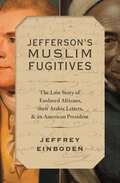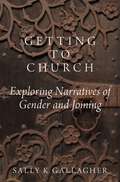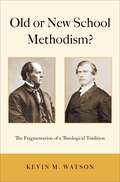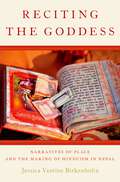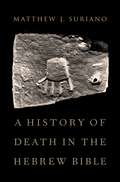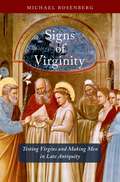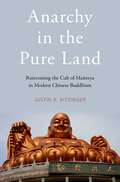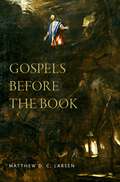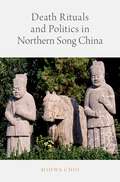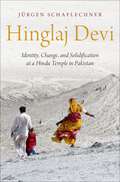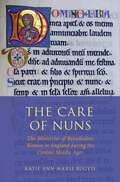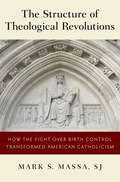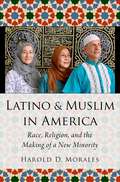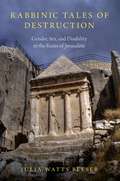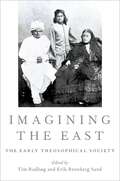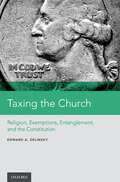- Table View
- List View
Jefferson's Muslim Fugitives: The Lost Story of Enslaved Africans, their Arabic Letters, and an American President
by Jeffrey EinbodenOn October 3, 1807, Thomas Jefferson was contacted by an unknown traveler urgently pleading for a private "interview" with the President, promising to disclose "a matter of momentous importance". By the next day, Jefferson held in his hands two astonishing manuscripts whose history has been lost for over two centuries. Authored by Muslims fleeing captivity in rural Kentucky, these documents delivered to the President in 1807 were penned by literate African slaves, and written entirely in Arabic. Jefferson's Muslim Fugitives reveals the untold story of two escaped West Africans in the American heartland whose Arabic writings reached a sitting U.S. President, prompting him to intervene on their behalf. Recounting a quest for emancipation that crosses borders of race, region and religion, Jeffrey Einboden unearths Arabic manuscripts that circulated among Jefferson and his prominent peers, including a document from 1780s Georgia which Einboden identifies as the earliest surviving example of Muslim slave authorship in the newly-formed United States. Revealing Jefferson's lifelong entanglements with slavery and Islam, Jefferson's Muslim Fugitives tracks the ascent of Arabic slave writings to the highest halls of U.S. power, while questioning why such vital legacies from the American past have been entirely forgotten.
GETTING TO CHURCH C: Exploring Narratives of Gender and Joining
by Sally K. GallagherWhy do people go to church? What about a congregation attracts new members? What is it that draws women and men differently into diverse types of congregations? Getting to Church assesses the deeply personal and gendered narratives around how women and men move toward identifying with three very different Christian congregations: one Orthodox, one conservative, and one mainline. Drawing on extensive research and ranging across layers of congregational history, leadership, architecture, new member process, programs, and service ministries, Sally Gallagher explores trajectories of joining, as well as membership loss and change over a seven-year period. By following both those who join a community and those who explore but choose not to, Gallagher avoids the methodological limitations of other studies and assesses the degree to which the spaces, people, programs, and doctrines within distinctive traditions draw women and men toward affiliation and involvement. Getting to Church demonstrates that women are attracted to specific doctrines and ideas, opportunities for individual reflection, experience and expanded personal agency; while men find in these congregations a sense of community within which they experience greater connection with other men, appreciate beauty, and yield to something greater than themselves. Drawing on extensive field work, personal interviews, and focus groups, Getting to Church challenges extant theories of gender and religious involvement.
Old or New School Methodism?: The Fragmentation of a Theological Tradition
by Kevin M. WatsonOn September 7, 1881, Matthew Simpson, Bishop in the Methodist Episcopal Church, in a London sermon asserted that, "As to the divisions in the Methodist family, there is little to mar the family likeness." Nearly a quarter-century earlier, Benjamin Titus (B.T.) Roberts, a minister in the same branch of Methodism as Simpson, had published an article titled in the Northern Independent in which he argued that Methodism had split into an "Old School" and "New School." He warned that if the new school were to "generally prevail," then "the glory will depart from Methodism." As a result, Roberts was charged with "unchristian and immoral conduct" and expelled from the Genesee Conference of the Methodist Episcopal Church (MEC). Old or New School Methodism? examines how less than three decades later Matthew Simpson could claim that the basic beliefs and practices that Roberts had seen as threatened were in fact a source of persisting unity across all branches of Methodism. Kevin M. Watson argues that B. T. Roberts's expulsion from the MEC and the subsequent formation of the Free Methodist Church represent a crucial moment of transition in American Methodism. This book challenges understandings of American Methodism that emphasize its breadth and openness to a variety of theological commitments and underemphasize the particular theological commitments that have made it distinctive and have been the cause of divisions over the past century and a half. Old or New School Methodism? fills a major gap in the study of American Methodism from the 1850s to 1950s through a detailed study of two of the key figures of the period and their influence on the denomination.
Old or New School Methodism?: The Fragmentation of a Theological Tradition
by Kevin M. WatsonOn September 7, 1881, Matthew Simpson, Bishop in the Methodist Episcopal Church, in a London sermon asserted that, "As to the divisions in the Methodist family, there is little to mar the family likeness." Nearly a quarter-century earlier, Benjamin Titus (B.T.) Roberts, a minister in the same branch of Methodism as Simpson, had published an article titled in the Northern Independent in which he argued that Methodism had split into an "Old School" and "New School." He warned that if the new school were to "generally prevail," then "the glory will depart from Methodism." As a result, Roberts was charged with "unchristian and immoral conduct" and expelled from the Genesee Conference of the Methodist Episcopal Church (MEC). Old or New School Methodism? examines how less than three decades later Matthew Simpson could claim that the basic beliefs and practices that Roberts had seen as threatened were in fact a source of persisting unity across all branches of Methodism. Kevin M. Watson argues that B. T. Roberts's expulsion from the MEC and the subsequent formation of the Free Methodist Church represent a crucial moment of transition in American Methodism. This book challenges understandings of American Methodism that emphasize its breadth and openness to a variety of theological commitments and underemphasize the particular theological commitments that have made it distinctive and have been the cause of divisions over the past century and a half. Old or New School Methodism? fills a major gap in the study of American Methodism from the 1850s to 1950s through a detailed study of two of the key figures of the period and their influence on the denomination.
Reciting the Goddess: Narratives of Place and the Making of Hinduism in Nepal
by Jessica Vantine BirkenholtzReciting the Goddess presents the first critical study of the Svasthanivratakatha (SVK), a sixteenth-century Hindu narrative textual tradition. The extensive SVK manuscript tradition offers a rare opportunity to observe the making of a specific, distinct Hindu religious tradition. Jessica Vantine Birkenholtz argues that the SVK serves as a lens through which we can observe the creation of modern 'Hinduism' in the Himalayas, as the text both mirrored and informed key moments in the self-conscious creation of Nepal as the 'world's only Hindu kingdom' in the late medieval and early modern period. Birkenholtz mines the literary historiography that is contained within the SVK text itself, chronicling the text's literary and narrative development as well as the development of the Svasthani goddess tradition. She outlines the process whereby the SVK gradually transformed into a Purana text, and became a critical source for Nepali Hindu belief and identity. She also examines the elusive character of the goddess Svasthani whose identity is tied to the pan-Hindu goddess tradition, and the representation of women in the SVK and the ways in which the text influenced local and regional debates on the ideal of Hindu womanhood. Reciting the Goddess presents Nepal's celebrated SVK as a micro-level illustration of the powerful ways in which people, place, and literature intersect to produce new ideas and concepts of identity and place, even in a historically non-literate culture.
A History of Death in the Hebrew Bible
by Matthew SurianoPostmortem existence in the Hebrew Bible/Old Testament was rooted in mortuary practices and conceptualized through the embodiment of the dead. But this idea of the afterlife was not hopeless or fatalistic, consigned to the dreariness of the tomb. The dead were cherished and remembered, their bones were cared for, and their names lived on as ancestors. This book examines the concept of the afterlife in the Hebrew Bible by studying the treatment of the dead, as revealed both in biblical literature and in the material remains of the southern Levant. The mortuary culture of Judah during the Iron Age is the starting point for this study. The practice of collective burial inside a Judahite rock-cut bench tomb is compared to biblical traditions of family tombs and joining one's ancestors in death. This archaeological analysis, which also incorporates funerary inscriptions, will shed important insight into concepts found in biblical literature such as the construction of the soul in death, the nature of corpse impurity, and the idea of Sheol. In Judah and the Hebrew Bible, death was a transition that was managed through the ritual actions of the living. The connections that were forged through such actions, such as ancestor veneration, were socially meaningful for the living and insured a measure of immortality for the dead.
A History of Death in the Hebrew Bible
by Matthew SurianoPostmortem existence in the Hebrew Bible/Old Testament was rooted in mortuary practices and conceptualized through the embodiment of the dead. But this idea of the afterlife was not hopeless or fatalistic, consigned to the dreariness of the tomb. The dead were cherished and remembered, their bones were cared for, and their names lived on as ancestors. This book examines the concept of the afterlife in the Hebrew Bible by studying the treatment of the dead, as revealed both in biblical literature and in the material remains of the southern Levant. The mortuary culture of Judah during the Iron Age is the starting point for this study. The practice of collective burial inside a Judahite rock-cut bench tomb is compared to biblical traditions of family tombs and joining one's ancestors in death. This archaeological analysis, which also incorporates funerary inscriptions, will shed important insight into concepts found in biblical literature such as the construction of the soul in death, the nature of corpse impurity, and the idea of Sheol. In Judah and the Hebrew Bible, death was a transition that was managed through the ritual actions of the living. The connections that were forged through such actions, such as ancestor veneration, were socially meaningful for the living and insured a measure of immortality for the dead.
Signs of Virginity: Testing Virgins and Making Men in Late Antiquity
by Michael RosenbergAlthough the theme of bloodied nuptial sheets seems pervasive in western culture, its association with female virginity is uniquely tied to a brief passage in the book of Deuteronomy detailing the procedure for verifying a young woman's purity; it seldom, if ever, appears outside of Abrahamic traditions. In Signs of Virginity, Michael Rosenberg examines the history of virginity testing in Judaism and early Christianity, and the relationship of these tests to a culture that encourages male sexual violence. Deuteronomy's violent vision of virginity has held sway in Jewish and Christian circles more or less ever since. However, Rosenberg points to two authors-the rabbinic collective that produced the Babylonian Talmud and the early Christian thinker Augustine of Hippo-who, even as they perpetuate patriarchal assumptions about female virginity, nonetheless attempt to subvert the emphasis on sexual dominance bequeathed to them by Deuteronomy. Unlike the authors of earlier Rabbinic and Christian texts, who modified but fundamentally maintained and even extended the Deuteronomic ideal, the Babylonian Talmud and Augustine both construct alternative models of female virginity that, if taken seriously, would utterly reverse cultural ideals of masculinity. Indeed this vision of masculinity as fundamentally gentle, rather than characterized by brutal and violent sexual behavior, fits into a broader idealization of masculinity propagated by both authors, who reject what Augustine called a "lust for dominance" as a masculine ideal.
Signs of Virginity: Testing Virgins and Making Men in Late Antiquity
by Michael RosenbergAlthough the theme of bloodied nuptial sheets seems pervasive in western culture, its association with female virginity is uniquely tied to a brief passage in the book of Deuteronomy detailing the procedure for verifying a young woman's purity; it seldom, if ever, appears outside of Abrahamic traditions. In Signs of Virginity, Michael Rosenberg examines the history of virginity testing in Judaism and early Christianity, and the relationship of these tests to a culture that encourages male sexual violence. Deuteronomy's violent vision of virginity has held sway in Jewish and Christian circles more or less ever since. However, Rosenberg points to two authors-the rabbinic collective that produced the Babylonian Talmud and the early Christian thinker Augustine of Hippo-who, even as they perpetuate patriarchal assumptions about female virginity, nonetheless attempt to subvert the emphasis on sexual dominance bequeathed to them by Deuteronomy. Unlike the authors of earlier Rabbinic and Christian texts, who modified but fundamentally maintained and even extended the Deuteronomic ideal, the Babylonian Talmud and Augustine both construct alternative models of female virginity that, if taken seriously, would utterly reverse cultural ideals of masculinity. Indeed this vision of masculinity as fundamentally gentle, rather than characterized by brutal and violent sexual behavior, fits into a broader idealization of masculinity propagated by both authors, who reject what Augustine called a "lust for dominance" as a masculine ideal.
Anarchy in the Pure Land: Reinventing the Cult of Maitreya in Modern Chinese Buddhism
by Justin RitzingerAnarchy in the Pure Land investigates the twentieth-century reinvention of the cult of Maitreya, the future Buddha, conceived by the reformer Taixu and promoted by the Chinese Buddhist reform movement. The cult presents an apparent anomaly: It shows precisely the kind of concern for ritual, supernatural beings, and the afterlife that the reformers supposedly rejected in the name of "modernity." This book shows that, rather than a concession to tradition, the reimagining of ideas and practices associated with Maitreya was an important site for formulating a Buddhist vision of modernity. Justin Ritzinger argues that the cult of Maitreya represents an attempt to articulate a new constellation of values, integrating novel understandings of the good, clustered around modern visions of utopia, with the central Buddhist goal of Buddhahood. In Part One he traces the roots of this constellation to Taixu's youthful career as an anarchist. Part Two examines its articulation in the Maitreya School's theology and its social development from its inception to World War II. Part Three looks at its subsequent decline and contemporary legacy within and beyond orthodox Buddhism. Through these investigations, Anarchy in the Pure Land develops a new framework for alternative understandings of modernity in Buddhism.
Gospels before the Book
by Matthew LarsenWhat does it look like to read the texts we now call the gospels like first- and second-century readers? There is no evidence of anyone regarding the gospel as a book published by an author until the end of the second century. So, put differently, what does it mean to read the gospels "before the book"? For centuries, the ways people discuss the gospels have been shaped by later ideas that have more to do with the printing press and modern notions of the author than ancient writing and reading practices. In Gospels before the Book, Matthew D. C. Larsen challenges several subtle yet problematic assumptions about authors, books, and publication at work in early Christian studies. He then explores a host of under-appreciated elements of ancient textual culture such as unfinished texts, accidental publication, post-publication revision, and the existence of multiple authorized versions of the same work. Turning to the gospels, he argues that the earliest readers and users of the text we now call the Gospel according to Mark treated it not as a book published by an author, but as an unfinished, open, and fluid collection of notes (hypomnmata). In such a scenario, the Gospel according to Matthew would not be regarded as a separate book published by a different author, but as a continuation of the same unfinished gospel tradition. Similarly it is not the case that, of the five different endings in the textual tradition we now call the Gospel according to Mark, one is "right" and the others are "wrong." Rather each represents its own effort to fill a perceived deficiency in the gospel. Larsen offers a new methodological framework for future scholarship on early Christian gospels.
Gospels before the Book
by Matthew LarsenWhat does it look like to read the texts we now call the gospels like first- and second-century readers? There is no evidence of anyone regarding the gospel as a book published by an author until the end of the second century. So, put differently, what does it mean to read the gospels "before the book"? For centuries, the ways people discuss the gospels have been shaped by later ideas that have more to do with the printing press and modern notions of the author than ancient writing and reading practices. In Gospels before the Book, Matthew D. C. Larsen challenges several subtle yet problematic assumptions about authors, books, and publication at work in early Christian studies. He then explores a host of under-appreciated elements of ancient textual culture such as unfinished texts, accidental publication, post-publication revision, and the existence of multiple authorized versions of the same work. Turning to the gospels, he argues that the earliest readers and users of the text we now call the Gospel according to Mark treated it not as a book published by an author, but as an unfinished, open, and fluid collection of notes (hypomnmata). In such a scenario, the Gospel according to Matthew would not be regarded as a separate book published by a different author, but as a continuation of the same unfinished gospel tradition. Similarly it is not the case that, of the five different endings in the textual tradition we now call the Gospel according to Mark, one is "right" and the others are "wrong." Rather each represents its own effort to fill a perceived deficiency in the gospel. Larsen offers a new methodological framework for future scholarship on early Christian gospels.
Death Rituals and Politics in Northern Song China
by Mihwa ChoiIn traditional China, a funeral and the accompanying death rituals represented a critical moment for the immediate family of the deceased to show their filial piety, a core value of the society. At the same time, death rituals were social occasions, and channels for the outward demonstration of belief in a religiously pluralistic society. During the Northern Song period, however, death rituals increasingly became an arena for political contention as attempts were made to transform these practices from a private matter into one subject to state control. Death Rituals and Politics in Northern Song China examines how political confrontations over the proper conduct of death rituals during Northern Song dynasty (960-1127) inaugurated a period of Confucian revivalism. Mihwa Choi interprets Northern Song court politics, family ritual practices, burial practices, and the popular imagination of the afterlife as sites of contest between groups of varying social status, political vision, and religious belief. She demonstrates that the oversight of ritual affairs by scholar-officials helped them gain the political upper hand they sought, and, more broadly, fostered a revival of Confucianism as the dominant value system of Chinese society in the period that followed.
Hinglaj Devi: Identity, Change, and Solidification at a Hindu Temple in Pakistan
by Jurgen SchaflechnerAbout two hundred kilometers west of the city of Karachi, in the desert of Baluchistan, Pakistan, sits the shrine of the Hindu Goddess Hinglaj. Despite the temple's ancient Hindu and Muslim history, an annual festival at Hinglaj has only been established within the last three decades, in part because of the construction of the Makran Coastal Highway, which connects the distant rural shrine with urban Pakistan. Now, an increasingly confident minority Hindu community has claimed Hinglaj as their main religious center, a site for undisturbed religious performance and expression. In Hinglaj Devi, Jürgen Schaflechner studies literary sources in Hindi, Sanskrit, Sindhi, and Urdu alongside extensive ethnographical research at the shrine, examining the political and cultural influences at work at the temple and tracking the remote desert shrine's rapid ascent to its current status as the most influential Hindu pilgrimage site in Pakistan. Schaflechner introduces the unique character of this place of pilgrimage and shows its modern importance not only for Hindus, but also for Muslims and Sindhi nationalists. Ultimately, this is an investigation of the Pakistani Hindu community's beliefs and practices at their largest place of worship in the Islamic Republic today--a topic of increasing importance to Pakistan's contemporary society.
Hinglaj Devi: Identity, Change, and Solidification at a Hindu Temple in Pakistan
by Jurgen SchaflechnerAbout two hundred kilometers west of the city of Karachi, in the desert of Baluchistan, Pakistan, sits the shrine of the Hindu Goddess Hinglaj. Despite the temple's ancient Hindu and Muslim history, an annual festival at Hinglaj has only been established within the last three decades, in part because of the construction of the Makran Coastal Highway, which connects the distant rural shrine with urban Pakistan. Now, an increasingly confident minority Hindu community has claimed Hinglaj as their main religious center, a site for undisturbed religious performance and expression. In Hinglaj Devi, Jürgen Schaflechner studies literary sources in Hindi, Sanskrit, Sindhi, and Urdu alongside extensive ethnographical research at the shrine, examining the political and cultural influences at work at the temple and tracking the remote desert shrine's rapid ascent to its current status as the most influential Hindu pilgrimage site in Pakistan. Schaflechner introduces the unique character of this place of pilgrimage and shows its modern importance not only for Hindus, but also for Muslims and Sindhi nationalists. Ultimately, this is an investigation of the Pakistani Hindu community's beliefs and practices at their largest place of worship in the Islamic Republic today--a topic of increasing importance to Pakistan's contemporary society.
The Care of Nuns: The Ministries of Benedictine Women in England during the Central Middle Ages
by Katie Ann-Marie BugyisIn her ground-breaking new study, Katie Bugyis offers a new history of communities of Benedictine nuns in England from 900 to 1225. By applying innovative paleographical, codicological, and textual analyses to their surviving liturgical books, Bugyis recovers a treasure trove of unexamined evidence for understanding these women's lives and the liturgical and pastoral ministries they performed. She examines the duties and responsibilities of their chief monastic officers--abbesses, prioresses, cantors, and sacristans--highlighting three of the ministries vital to their practice-liturgically reading the gospel, hearing confessions, and offering intercessory prayers for others. Where previous scholarship has argued that the various reforms of the central Middle Ages effectively relegated nuns to complete dependency on the sacramental ministrations of priests, Bugyis shows that, in fact, these women continued to exercise primary control over their spiritual care. Essential to this argument is the discovery that the production of the liturgical books used in these communities was carried out by female scribes, copyists, correctors, and creators of texts, attesting to the agency and creativity that nuns exercised in the care they extended to themselves and those who sought their hospitality, counsel, instruction, healing, forgiveness, and intercession.
CARE OF NUNS C: The Ministries of Benedictine Women in England during the Central Middle Ages
by Katie Ann-Marie BugyisIn her ground-breaking new study, Katie Bugyis offers a new history of communities of Benedictine nuns in England from 900 to 1225. By applying innovative paleographical, codicological, and textual analyses to their surviving liturgical books, Bugyis recovers a treasure trove of unexamined evidence for understanding these women's lives and the liturgical and pastoral ministries they performed. She examines the duties and responsibilities of their chief monastic officers--abbesses, prioresses, cantors, and sacristans--highlighting three of the ministries vital to their practice-liturgically reading the gospel, hearing confessions, and offering intercessory prayers for others. Where previous scholarship has argued that the various reforms of the central Middle Ages effectively relegated nuns to complete dependency on the sacramental ministrations of priests, Bugyis shows that, in fact, these women continued to exercise primary control over their spiritual care. Essential to this argument is the discovery that the production of the liturgical books used in these communities was carried out by female scribes, copyists, correctors, and creators of texts, attesting to the agency and creativity that nuns exercised in the care they extended to themselves and those who sought their hospitality, counsel, instruction, healing, forgiveness, and intercession.
The Structure of Theological Revolutions: How the Fight Over Birth Control Transformed American Catholicism
by Mark S. MassaOn July 29, 1968, Pope Paul VI ended years of discussion and study by Catholic theologians and bishops by issuing an encyclical on human sexuality and birth control entitled Humanae Vitae: "On Human Life." That document, which declared that "each and every marriage act must remain open to the transmission of life," lead to widespread dissent and division within the Church, particularly in the United States. The divide that Humanae Vitae opened up is still with us today. Mark Massa argues that American Catholics did not simply ignore and dissent from the encyclical's teachings on birth control, but that they also began to question the entire system of natural law theology that had undergirded Catholic thought since the days of Aquinas. Natural law is central to Catholic theology, as some of its most important teachings on issues such as birth control, marriage, and abortion rest on natural law arguments. Drawing inspiration from Thomas Kuhn's classic work The Structure of Scientific Revolutions, Massa argues that Humanae Vitae caused a paradigm shift in American Catholic thought, one that has had far-reaching repercussions. How can theology-the study of God, whose nature is imagined to be eternal and unchanging- change over time? This is the essential question that The Structure of Theological Revolutions sets out to answer. Massa makes the controversial claim that Roman Catholic teaching on a range of important issues is considerably more provisional and arbitrary than many Catholics think.
The Structure of Theological Revolutions: How the Fight Over Birth Control Transformed American Catholicism
by Mark S. MassaOn July 29, 1968, Pope Paul VI ended years of discussion and study by Catholic theologians and bishops by issuing an encyclical on human sexuality and birth control entitled Humanae Vitae: "On Human Life." That document, which declared that "each and every marriage act must remain open to the transmission of life," lead to widespread dissent and division within the Church, particularly in the United States. The divide that Humanae Vitae opened up is still with us today. Mark Massa argues that American Catholics did not simply ignore and dissent from the encyclical's teachings on birth control, but that they also began to question the entire system of natural law theology that had undergirded Catholic thought since the days of Aquinas. Natural law is central to Catholic theology, as some of its most important teachings on issues such as birth control, marriage, and abortion rest on natural law arguments. Drawing inspiration from Thomas Kuhn's classic work The Structure of Scientific Revolutions, Massa argues that Humanae Vitae caused a paradigm shift in American Catholic thought, one that has had far-reaching repercussions. How can theology-the study of God, whose nature is imagined to be eternal and unchanging- change over time? This is the essential question that The Structure of Theological Revolutions sets out to answer. Massa makes the controversial claim that Roman Catholic teaching on a range of important issues is considerably more provisional and arbitrary than many Catholics think.
Latino and Muslim in America: Race, Religion, and the Making of a New Minority (AAR Religion, Culture, and History)
by Harold D. MoralesLatino and Muslim in America examines how so-called "minority groups" are made, fragmented, and struggle for recognition. The U.S. is poised to become the first nation whose collective minorities outnumber the dominant population, and Latinos play no small role in this world-changing demographic shift. Even as many people view Latinos and Muslims as growing threats, Latino Muslims celebrate their intersecting identities in their daily lives and in their mediated representations. In this book, Harold D. Morales follows the lives of several Latino Muslim leaders from the 1970's to the present, tracing their efforts to organize and unify nationally in order to solidify the new identity group's place within the public sphere. Drawing on four years of media analysis, ethnographic and historical research, Morales demonstrates that Latinos embrace Islam within historically specific contexts that include distinctive immigration patterns and new laws, urban spaces, and media technologies that have increasingly brought Latinos and Muslims into contact. He positions this growing community as part of the mass exodus out of the Catholic Church, the growth of Islam, and the digitization of religion. Latino and Muslim in America explores the interactions between religion, race, and media to conclude that these three categories are inextricably entwined.
Latino and Muslim in America: Race, Religion, and the Making of a New Minority (AAR Religion, Culture, and History)
by Harold D. MoralesLatino and Muslim in America examines how so-called "minority groups" are made, fragmented, and struggle for recognition. The U.S. is poised to become the first nation whose collective minorities outnumber the dominant population, and Latinos play no small role in this world-changing demographic shift. Even as many people view Latinos and Muslims as growing threats, Latino Muslims celebrate their intersecting identities in their daily lives and in their mediated representations. In this book, Harold D. Morales follows the lives of several Latino Muslim leaders from the 1970's to the present, tracing their efforts to organize and unify nationally in order to solidify the new identity group's place within the public sphere. Drawing on four years of media analysis, ethnographic and historical research, Morales demonstrates that Latinos embrace Islam within historically specific contexts that include distinctive immigration patterns and new laws, urban spaces, and media technologies that have increasingly brought Latinos and Muslims into contact. He positions this growing community as part of the mass exodus out of the Catholic Church, the growth of Islam, and the digitization of religion. Latino and Muslim in America explores the interactions between religion, race, and media to conclude that these three categories are inextricably entwined.
Rabbinic Tales of Destruction: Gender, Sex, and Disability in the Ruins of Jerusalem
by Julia Watts BelserIn Rabbinic Tales of Destruction, Julia Watts Belser examines early Jewish accounts of the Roman conquest of Judea. Faced with stories of sexual violence, enslavement, forced prostitution, disability, and bodily risk, Belser argues, our readings of rabbinic narrative must wrestle with the brutal body costs of Roman imperial domination. She brings disability studies, feminist theory, and new materialist ecological thought to accounts of rabbinic catastrophe, revealing how rabbinic discourses of gender, sexuality, and the body are shaped in the shadow of empire. Focusing on the Babylonian Talmud's longest sustained account of the destruction of the Temple, Belser reveals Bavli Gittin's distinctive sex and gender politics. While Palestinian tales frequently castigate the 'wayward woman' for sexual transgressions that imperil the nation, Bavli Gittin's stories do not portray women's sexuality as a cause of catastrophe. The Bavli's resistance to Rome makes a critical difference. While other rabbinic texts commonly inveigh against women's beauty as the cause of sexual sin, Bavli Gittin's tales express a strikingly egalitarian discourse that laments the vulnerability of the beautiful Jewish body before the conqueror. Bavli Gittin's body politics, Belser maintains, align with a significant theological reorientation. While most early Jewish narratives link the destruction of the Temple to communal sin, Bavli Gittin's account does not explain catastrophe as divine chastisement. Instead of imagining God as the architect of Jewish suffering, it evokes God's empathy with the subjugated Jewish body. As it navigates the ruins of Jerusalem, Bavli Gittin forges a sharp critique of empire. Its critical discourse aims to pierce the power politics of Roman conquest, to protest the brutality of imperial dominance, and to make plain the scar that Roman violence leaves upon Jewish flesh.
Imagining the East: The Early Theosophical Society (Oxford Studies in Western Esotericism)
The Theosophical Society (est. 1875 in New York by H. P. Blavatsky, H. S. Olcott and others) is increasingly becoming recognized for its influential role in shaping the alternative new religious and cultural landscape of the late nineteenth and the twentieth century, especially as an early promoter of interest in Indian and Tibetan religions and philosophies. Despite this increasing awareness, many of the central questions relating to the early Theosophical Society and the East remain largely unexplored. This book is the first scholarly anthology dedicated to this topic. It offers many new details about the study of Theosophy in the history of modern religions and Western esotericism. The essays in Imagining the East explore how Theosophists during the formative period understood the East and those of its people with whom they came into contact. The authors examine the relationship of the theosophical approach with orientalism and aspects of the history of ideas, politics, and culture at large and discuss how these esoteric or theosophical representations mirrored conditions and values current in nineteenth-century mainstream intellectual culture. The essays also look at how the early Theosophical Society's imagining of the East differed from mainstream 'orientalism' and how the Theosophical Society's mission in India was distinct from that of British colonialism and Christian missionaries.
Imagining the East: The Early Theosophical Society (Oxford Studies in Western Esotericism)
by Tim Rudbøg, Erik Reenberg SandThe Theosophical Society (est. 1875 in New York by H. P. Blavatsky, H. S. Olcott and others) is increasingly becoming recognized for its influential role in shaping the alternative new religious and cultural landscape of the late nineteenth and the twentieth century, especially as an early promoter of interest in Indian and Tibetan religions and philosophies. Despite this increasing awareness, many of the central questions relating to the early Theosophical Society and the East remain largely unexplored. This book is the first scholarly anthology dedicated to this topic. It offers many new details about the study of Theosophy in the history of modern religions and Western esotericism. The essays in Imagining the East explore how Theosophists during the formative period understood the East and those of its people with whom they came into contact. The authors examine the relationship of the theosophical approach with orientalism and aspects of the history of ideas, politics, and culture at large and discuss how these esoteric or theosophical representations mirrored conditions and values current in nineteenth-century mainstream intellectual culture. The essays also look at how the early Theosophical Society's imagining of the East differed from mainstream 'orientalism' and how the Theosophical Society's mission in India was distinct from that of British colonialism and Christian missionaries.
Taxing the Church: Religion, Exemptions, Entanglement, and the Constitution
by Edward A. ZelinskyThis book explores the taxation and exemption of churches and other religious institutions, both empirically and normatively. This exploration reveals that churches and other religious institutions are treated diversely by the federal and state tax systems. Sectarian institutions pay more tax than many believe. In important respects, the states differ among themselves in their respective approaches to the taxation of sectarian entities. Either taxing or exempting churches and other sectarian entities entangles church and state. The taxes to which churches are more frequently subject - federal Social Security and Medicare taxes, sales taxes, real estate conveyance taxes - fall on the less entangling end of the spectrum. The taxes from which religious institutions are exempt - general income taxes, value-based property taxes, unemployment taxes - are typically taxes with the greatest potential for church-state enforcement entanglement. It is unpersuasive to reflexively denounce the tax exemption of religious actors and institutions as a subsidy. Tax exemption can implement the secular, non-subsidizing goal of minimizing church-state enforcement entanglement and thus be regarded as part of a normative tax base. Taxing the church or exempting the church involves often difficult trade-offs among competing and legitimate values. On balance, our federal system of decentralized legislation reasonably make these legal and tax policy trade-offs, though there is room for improvement in particular settings such as the protection of internal church communications and the expansion of the churches' sales tax liabilities.
